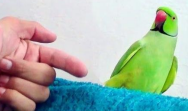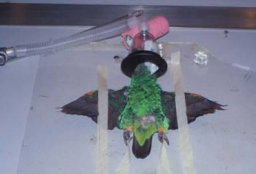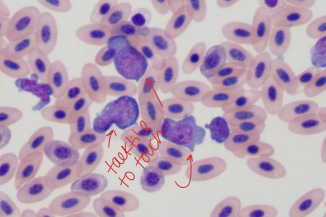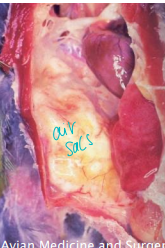Avian Exotics
1/93
Earn XP
Description and Tags
Name | Mastery | Learn | Test | Matching | Spaced |
|---|
No study sessions yet.
94 Terms
Pet bird types by class
Psittacines: Parrots, parakeets, cockatoos, cockatiels, macaws
Old world: Cockatoos, African greys, Eclectus, Lovebirds, Cockatiels, Budgerigars
New world: Macaws, Amazons, Quaker/Monk, Conures
Flock species, intelligent
Don’t mix old and new world
Passerines: Canaries, finches, mynahs
flock species
Galliformes: Chickens, pheasants, turkeys, grouse
flock species
Rhamphastids: Toucans, toucanets, aracari
NOT flock species

Cockatoos
ID: Lg old world psittacines
Looks: Crest, prominent powder down feathers
Dx: Feather picking/cloacal prolapse, obesity
Behaviour: flock, intelligent, clingy, LOUD, kinda talk
Very social and affectionate
Life span: 50y
From: Australia, New Zealand, Pacific islands
Need constant companionship and
supervision
not a good 1st bird


Cockatiels
ID: Sm old world psittacines
Looks: grey, white wings, yellow crest, orange cheek
Behaviour: flock, cuddly, poor talkers
good first bird
Very social


Budgerigar
Budgies
ID: Sm old world psittacines
Looks: No crest, colourful
Dx: Obesity, lipoma, goiter, PBFD, polyomavirus, neoplasia, repro, megabacteria
Behaviour: males talk, alone or groups
good first bird
Very personal
Life span: 7-9y
From: Australia


Eclectus
ID: Med old world psittacines
Looks: Sexually dimorphic
Dx: PBFD, polyomavirus, feather destructive behavior, beak abnormalities
Behaviour: shy males, bossy girls, loud, poor talkers, smart, independent
Life span: 30y


African Grey Parrot
ID: Med old world psittacines
Dx: Hypocalcemia, Atherosclerosis, PBFD, Resp aspergillosis
Behaviour: intelligent, good talkers, social, necrotic
not cuddlers
Life span: 40y

Lovebirds
ID: Sm old world psittacines
Dx: Repro problems, PBFD, Trauma, Megabacteria, Encephalitozoon hellum
Behaviour: active, social, strong bonds
Life span: 12y

Macaws
ID: Lg new world psittacines
Looks: bare facial area with or without short feathers, long tail
Dx: papillomatosis, polyomavirus, pedal herpesvirus, Chlamydiosis, PDS/PDD, Pulmonary hypersensitivity
Behaviour: Loud, needy, bite, destructive, physical, smart
play rough with them
Life span: 50y


Amazon Parrots
ID: Med new world psittacines
Looks: green, blue, yellow
Dx: chlamydiosis, mycobacteriosis, pox, papillomatosis, polyomavirus, obesity, fatty liver
Behaviour: Loud, talkative, needy, clowns
Life span: 40y


Conures
ID: Sm new world psittacines
Looks: Bare periorbital skin, long tail
Dx: Pacheco’s, polyoma, PBFD, Liver disease
Behaviour: Loud, poor talkers, chewers
Life span: 15y


Monk or Quaker Parrots
ID: Sm new world psittacines
Dx: Pacheco’s, polyoma, PBFD, Liver disease
Behaviour: Active, stressy, poor talkers, social
Life span: 15y

Canaries
ID: Passerine
Dx: mites, Mycoplasma URI
Behaviour: flock aviary
Life: 5-15y


Finches
ID: Passerine
Dx: mites, Mycoplasma URI, GI parasites, Avian Gastric Yeast
Behaviour: mixed flock aviary
Life: 10y
Mynahs
ID: Passerine
Dx: mites, Mycoplasma URI
Behaviour: flock aviary
Life: 15y

Catching the Bird
Be comfortable, make it voluntary, be interesting
Step up (arm/dowel) on wrist or hand
not shoulder, bend down next to cadge if happens
Hold foot w/ thumb and bend elbow
“Little earthquake” if they try and bit
Stretch the bird and catch the face

Toweling a bird
Use towel as a false wall or drop towel
Grab head and wrap towel around body keeping the head exposed
Make it positive and train at home
Don’t squeeze

Restraining birds
Lg birds
Neck + mandible w/ one hand, feet w/ the other
Med birds
Two fingers mandible side, one on top of head
Fast ball
Sm birds
Neck between distal fingers, feet on thumb
One handed cigarette hold

Physical exam
Pre handling: resp, behaviour
Systematic: head to tail
Oral: pen light, choana (narrow w/ sharp papilla)
no epiglottis
Eye: No menace, skin turgor, diminished PLR
3-5% dehydration = slow return
5-8% dehydration = no return
Neck: cervical bulge is normal
Auscultation: over the keel
Heart: over keel, 200-500bpm
Lungs: dorsal body, should be quite, abdomen to hear air sac sounds
Abdomen: mostly empty, ventriculus on left, left is full w/ repro activity
Skin: bruising is green(biliverdin), barbering is typically localized, cloaca is clean/dry and evert
Avian housing
Size
Extend wings
Material
No wood, plastic, galvanized wire
Sm birds = ¼ ” bar spacing
Med birds = ½ “ bar spacing
Lg birds = 1” bar spacing
Food and water access
multiple points if grouped
Water Available 24/7
keep high up and change daily
Avian enrichment
Perching: variety sizes, heights, & textures
avoid abrasive surfaces
Nests: Avoid unless breeding
Substrate: paper
Avoid corn cob, wood chips
Toys: variety, puzzles, chews, foraging
Lack may affect cerebral dev
Buddies: same size, species, or continent (old/new world)
cadge mates or neighbors
Avian environmental parameters
Varies w/ species
Temp: warmer if sm
Humidity: Supplement in winter, bathing/showers/mist
Light cycles: 12hr cycles
Avian household hazards
Physical: Windows, mirrors, open water
Chemical: Lead, zinc, teflon, aerosols
Smoke: Dyspnea, immunosuppression
Nicotine: conjunctivitis, rhinitis, atherosclerosis
Air fresheners: irritation
Teflon: >530F
CS: dyspnea, weakness, acute death, pulmonary hemorrhage
Tx: ventalate, Bronchodilators
Lead:
MOA: Acid enviro rxn and binds to RBC’s
CS: anemia, green diarrhea, GI stasis, seziures, paralysis
ID: rads, whole bld
Tx: chelation (D-penicillamine, DMSA, CaEDTA)
Diet: chocolate, avocado, alcohol

Identification of Birds
Leg bands: closed band w/ state/year of birth, aviary, #
Transponders: Insert in pectoral mm
Sexing:
Dimorphic: Eclectus, Ring-neck parakeet, Budgies, Cockatiels
DNA sexing: Zoogen, Avigen - blood test
Aging: eyes, feathers, beak colour
Young: darker eyes
Older: white/yelloww/red/orange eyes
Avian Nutrition
Texture > taste
Energy req varies: season, photoperiod, stress
Repro: high Ca, fat, protein, Vit A/D
Growth: feed for a linear growth rate till weaning
Made of: Seeds, nuts, fruits/veg, insects
Types: home made, manufactured, supplements, seed based
Water: 1-2 oz/lb/day
keep up high and fresh
Avaible 24/7
Supplements in birds
if eating <50% a manufactured diet
Home made diets
in active in water after 30min
needs moist foods to stick
Mineral block/cuttlebone for laying birds
Homemade diets in birds
Needs supplements
Use caratenoids, proteins (usu. legumes), fat (seeds), fruits (sugar), wheat (starch), vit/mineral supplements
poorly analyzed and balanced
Not recommended
Pelleted diets
Sm birds: Pellets should be 50% of diet
Lg birds: Pellets 60-75% of diet
Pellet Size: Use the smallest possible
Lg particles cause impaction
Formulations:
Specialized: liver/kidney dx, obesity management, hypoallergenic
Nutriberries: Nutritionally the same as pellets
Hulled seeds and supplements stuck together
Seed based bird diets
Made of:
Oil seeds: high fat and protein
Rape seed, sunflower, safflower, peanut
Non-oil seeds: high carbs
Millet, canary seeds, oat groats
Deficient in 20 nutrients
vitA,B12,C, AA, Ca, Mn, Na, Zn, I, Se
Changing the Diet in Birds
May not recognize new item as food
monkey see-monkey do
Go slow: add 25% of new food every week
The Switch: place new food in old bowl and offer as a snack
Waste analysis in birds
Feces: toothpaste consistency
Urates: dollop of white-ish material
Uric acid component
Urine: thin outline of dropping
Water component
Obesity
MOA:
High fat diet, min exercise
Amazons, lovebirds, galahs, budgies
Tx:
25% decrease a week
Reduce weight by 1% per week
Hepatic lipidosis is common

Vit A deficiency
Normal:
Stored in liver
For Vision/repro/skin/immunity
MOA: Seed based diet
CS:
Lesions: thickening of skin, poor feather condition/colour, Wide+blunt choana, oral plaques and abcess
Resp dx: Chronic sinusitis
Kidney failure: thick ureters, uric acid sludging


Calcium deffiecncy
Normal:
Coagulation, bone dev, egg dev
Absorption in small intestines reg by vit D
1% of diet
MOA: diet, low vit D, egg production
CS: Weakness, lethargy, seizures, tremors, splay leg, folding fractures, bld issues, egg binding
metabolic bone dx
ID: Xray evaluation of bone quality and ionized
Tx: parenteral D3, diet change


Iodine imbalances
Normal:
for thyroid hormone synthesis
absorbed in intestines
MOA:
Deficiency and excess
budgerigar
CS: Resp signs, regurgitation, Goider, new squeak

Gout
Uric acid Excreted in the distal tubules in normal bird
MOA:
High UA, protein
Low Vit A, dehydration
CS: renal dx, joint inflammation
Visceral form: deposition of tophi
Articular form: deposits in joints
ID: high UA, high opacity on Xray, joint biopsy
Tx: Allopurinol (inhibits), Colchicine (anti-fibrotic)


How do you tell if a bird will bite
Pupils: rapidly changing
Speed: fast is bad
Tongue: in mouth is bad
out is questioning (good)
Feathers: up is bad
Posture: Wings out is bad
Foot up (good)
Bird Nail Trims
Similar to small animals
Clip from sides
Human nail clippers, feline nail trimmers, emery board, dremel, Cautery pen

Wing Trimming
Ask preference client
one wing, both wings
Look for blood feathers
new feather in a sheath
Trim primary feathers: usually
Long, sharp scissors
Beak Trimming
Too long if points back towards body
liver dx if thick, irregular, overgrown
Watch for bld, nerves, and Herbst corpuscles in beak
Use Dremel to trim and shape
can use clipers on thin tips

Patient Positioning of Radiographs
Sedation or inhalant required
need to fast (1-4h)
have everything ready before induction
Must be tabletop
Ventrodorsal view
extended wings and feet
tape limbs
Lateral view: can be either right or left
Lower wing cranial to upper wing
Lower leg cranial to upper leg


The avian GIT in radiographs
Crop is right of thoracic inlet
Proventriculus
45o in ‘thorax’
starts dorsal to heart
dorsal to left liver lobe
Ventriculus is left at level of hip
contains radiopaque particles


The Avian Liver on Radiographs
2 lobes
Cranial edge wraps around apex of heart
Creates cardiac-hepatic waist
lies between line drawn between greater trochanter and shoulder

Cardiopulmonary System on radiographs
Heart is cranial to liver
cardiohepatic silhouette
Major vessels visible on lateral
Lungs lie against dorsal body wall and have honeycomb appearance
Air sacs not visible unless inflamed
9 air sacs

avian urogenital System on radiographs
Kidneys lie ventral to pelvis in renal fossa of synsacrum
may have increased opacity with gout or inflammation
No bladder in birds
except ostrich
Genitals may be visible, especially in breeding season
Female reproductive tract on left


The avian skeleton on radiographs
Thin cortices & increased trabecular bones: flight
Humerus and femur are pneumatic
8 thoracic vertebrae in psittacines
Pygostyle: end of caudal vertebrae
flight feathers attach
Synsacrum: pelvis and lumbar vertebrae
Shoulder: coracoid, scapula, humerus, clavicle
Ulna is larger than radius
Carpal bones: radiocarpal, ulnar carpal (2)
Toes: zygodacty
# 1+ clockwise from caudomedial digit
Alula is ‘thumb’ in wing
Fused tarsus: tibiotarsus, tarsometatarsus
Knee: fibula is incomplete and patella isn’t visible

The Avian CBC
can draw 1% of BW
PCV, WBC and differential
Estimated WBC: count leukocytes on 40x wright stain bld smear, x5/5, x2000
Eosinophil Stain: hemacytometer, count eosinophils/heterophils
WBC = #cellsx1778 / % eosinophils/heterophils
Wright stain
Samples collected in heparin
Granulocytic cells: heterophil, eosinophil, basophil
Mononuclear cells: lymphocyte, monocyte
White blood cell abnormalities
High: infectious dx, inflam, stress, young
bacterial, TB, chlamydial, and fungal
Low: chronic dx, sepsis, toxins, bone marrow dx, artifacts

The Avian Heterophil
Fresh blood
ID: Lobed nucleus w/ pink, rod-shaped granules
1st responders to inflammation, infection
MOA: phagocytic, bactericidal, first responder
Equivalent to mammalian neutrophil
Toxic changes: Basophilic inclusions, cytoplasmic vacuolization, basophilia, nuclear hypersegmentation
overwhelming infections
Band cells: No nuclear segmentation, blue cytoplasm
severe infection
High: infections, stress, trama, toxins, inflam
Low: chronic dx, Pacheco’s virus, PBFD
normal in canaries and amazons

The Avian Eosinophil
ID: Lobulated nucleus w/ round, pink granules in cytoplasm
MOA: peroxidases, arginine, parasitic dx, delayed hypersensitivity


The Avian Basophil
ID: Lobulated nucleus w/ large, dark cytoplasmic granules
Granules may be affected by stains
MOA: Produce, store, release histamine
hypersensitivity, edema, smooth muscle contraction, thrombocyte activation


The Avian Lymphocyte
ID: Large nucleus with margin of light blue cytoplasm
MOA: Cellular and humoral immune response
High: chronic infectious dx, lymphoid leukemia
canaries, Amazons
Low: chronic dx, viral dx

The Avian Monocyte
ID: Lg, round to amoeboid cell w/ lg bluish cytoplasm w/ vacuoles
MOA: antigen processing, Bacti phagocytosis, resp burst
High: chlamydiosis, granulomas, necrosis

The Avian Erythrocyte
ID: Lg, oval, nucleated cell
MOA: Shorter life-span than mammalian
Anemia: chronic dx, loss, toxins
Normal PCV: 40-50%

The Avian Thrombocyte
ID: Sm, darkly nucleated oval to round cell
clumps
MOA: coagulation, bacti phagocytosis
Avian AST
MOA: not liver specific, more reliable then others
Always measure CK too
best leakage enzyme
Use other tests if CK and AST elevated
Total Protein in birds
Normal: 2.5-5.0
Total solids not reliable
EPH is only way to test albumin and globulins
Low: young, poor diet, GIT/renal loss, liver dx, overhydration
Lower than mammals
High: dehydration, egg laying, inflam
Calcium measuring in birds
Measures as total calcium
ionized is tighlty controled
Impacted by low proteins
Artifactual decreases with EDTA and hypoproteinemia
Low: nutritional, metabolic disease, hypoproteinemia, inadequate UV exposure
CS: trembling, weakness, lethargy, seizures
Risk: African gray parrots
High: egg laying, rare
Iatrogenic most common
Phosphorus in birds
1/2 Ca level
High: artifact of hemolysis/storage, renal disease
Low: artifact
Uric Acid in birds
Final nitrogenous waste product
Normal: 4-10
Excreted in renal tubule
High: carnivorous meals, dehydration
Blood Glucose in Birds
Higher than mammals - 300-400 mg/dl
Diabetes mellitus rare
Low: starvation, maldigestion, malabsorption, diet
Assessing Liver Disease in birds
CS: Green urates, sternal lift, abdominal distension
ID: Hepatomegaly on radiographs/ultrasound
High: AST, bile acids
Normal CK
Low: protien, Ca
Bile Acids in birds
High: hepatic dx
High Post-prandial: <2x resting level, presence of gallbladder does not change
Single sample: fasted is the best
Normal: <70, non faster: <100
Assessing Renal Disease in birds
CS: Polyuria, polydypsia, diarrhea, abdominal mass/distension
ID: Renomegaly on radiographs/ultrasound
High: uric acid, Phosphorus
Low: Ca and protein

Avian Polyoma Virus
MOA:
feces, budgies, resp, crop
incubates 11-15d in budgies, 2-14d in other
Organ enlargement and necrosis
Types
Budgie fledgling disease
MOA: Budgerigar form, at birth
CS: sudden death <15d old, death certain
Non-Budgie Form
AKA: Fulminate disease (nestlings)
MOA: 48hr is common chronic is rare
CS: Depression, regurgitation, diarrhea, SQ hemorrhages, abdominal distension
adults asymptomatic
ID: Necropsy: dead/bloated, Intra-nuclear inclusions, DNA probe(asymp)
TX: none, vax @ 4 and 8w
Psittacine Beak and Feather Disease
MOA: Only circovirus in psittacines
>3y is resistant
ingestion/inhalation
CS: progressive feather/beak lesions
downy in adults, whole body in young
Shinny beaks, then brittle/necrotic
What other virus can cause weird feathering in birds that recover from the early stages?
ID: DNA probe, Hemagglutination(antibody), Basophilic inclusions
Tx: none, support, quarantine + retest in 90d

Chlamydia
MOA: Gram -
feces, resp, ocular secretions, enviro contamination!!
Biphasic life cycle (Reticulate and elementary body)
stress triggered
zoonotic and reportable
CS: profuse diarrhea, biliverdinuria, depression, resp dx, Hepato-splenomegaly
none, acute, chronic forms
ID: Big livers/biopsy
CBC/Chem: Leukocytosis, anemia, High AST/Bile acids, Beta/gamma globinulinopathy
Rads/US: Hepato-splenomegaly; air sacculitis, hyperechoic liver and spleen
Cytology: Heterophilic/macrophagic inflam
Blds: PCR, direct complement fixation (IgG), early elementary body agglutination (IgM)
Tx: Doxycycline 14-45d
not immune post tx
Bite Wounds
MOA: P. multocida in SA
CS: fatal septicemia
TX: flush and antibiotics
even if no bite wounds visible
Blood feather damage
MOA: growing feather has bld supply
Tx: pull feather, hemostatic agents, pressure

Unilateral Lameness in birds
MOA: renal tumors (sciatic dx)
sm birds (budgies)
ID: rads
CS: Withdrawal present but unable to move rest of leg
Tx: none
Hemorrhage
MOA: <25% is mild, severe >30%
TX: Treat like hypovolemic shock
Mild: fluids + iron
Severe: transfusion
give 10-20% of bld volume, closely related donor as possible

Oral Candidiasis
MOA: Candida albicans
Often secondary to other disease or long-term antibiotic use (young)
ID: cytology w/ gram or Diff-Quick
Tx: Nystatin(mild), chlorhexidine, ketoconazole(servere), fluconazole

Malocclusions
MOA:
Macaws and cockatoos
Improper hand-feeding, genetics, diet
TX: physical therapy
Crop diseases
Sour crop or Crop Stasis
MOA: poor husbandry w/ secondary infection
ID: cytology, culture: crop swab,
TX: Crop flushes, antibiotics, sm meals, crop ‘bra
Crop Fistulas
MOA: thermal injury to crop
CS: tissue necrosis, food leakage
TX: sx

Proventricular diseases
ABV + birds don’t all have PDD
Avian Bornavirus(fatal) or PDD
CS: lymphoplasmacytic neuritis, weight loss, delayed crop emptying, passage of undigested food in droppings
ID: enlarged, food filled proventriculus on rads, crop biopsy, PCR, Anti-gangliocide abs
TX: supportive, COX-2 inhibitors
Foreign Bodies
MOA: in proventriculus or ventriculus
CS: impactions and regurgitation
TX: laxatives, flushing, endoscopy, sx proventriculotomy

Intestinal diseases in birds
Bacterial Enteritis
MOA: Most common cause of diarrhea in pet birds
Gram - bacteria
Campylobacter, Clostridium(saftey pin)
ID: fecal culture/cytology
Mycobacteriosis
MOA: gram positive, fecal-oral, enviro
Tubercles form throughout GIT/liver
Zoonotic
CS: Weight loss, voluminous diarrhea
ID: requires biopsy/culture w/ acid fast stain, PCR
Bld: Leukocytosis, monocytosis, high AST/bile acids, Beta/gamma globulinopathies
Rads: Thickened bowel loops, hepatomegaly
TX: multiple-drug (Isoniazid, ethambutol, clarithromycin), euth


Cloaca diseases
Prolapse
MOA: Chronic egg-laying, egg binding, constipation, nutritional dx, behavioral dx
ID: pink, glistening tissue outside of vent
CS: Straining to defecate, abnormal defecation
TX: mannual replace, hypertonics (shrink), hormones, diet, cloacopexy/cloacoplasty
Papilloma
MOA: Amazons and macaws
CS: irregular cobblestone masses, bloody droppings, tenesmus, odiferous feces, and flatulence
ID: biopsy, vinegar
TX: Sx, spontaneous
Gastric anatomy in birds
Duodenum U-shaped around pancreas
Midline incision
Some birds have paired ceca
Avain resp system anatomy
Trachea: Complete, signet-shaped cartilage w/ overlap
Atria: Contain air capillaries
Air capillaries: Avian version of alveoli: GAS exchange
Secondary bronchi communicate with lungs and air sacs
Parabronchi and blood vessels at 90o
Cross-current flow
Two breath cycle
First cycle: Trachea > caudal air sacs > lungs
Second Cycle: Lungs > cranial air sacs > cranial air sacs > trachea

General Resp diseases signs and treatment
Upper resp dx:
CS: Open-mouthed breathing, high RR, nasal discharge (bld = trama/FB/Cancer), Groove in beak, abnormal nares, facial swelling
ID: discharge/plug cytology and culture, flush
TX: O2 mask cadge, antibiotics/antifungals
Lg airway dx:
MOA: tracheal granulomas, FBs, thyroid
CS: high pitched/click, open mouth breathing, high resp effort, wet sounds
TX: O2 mask cadge, Terbutaline, Air sac cannula
Sm airway dx
MOA: inhaled toxins, smoke, asthma!
CS: Open-mouthed breathing, Wide-based stance, Wings abducted
TX: O2 mask cadge, Terbutaline, Diphenhydramine, Meloxicam
Parenchymal dx
MOA: lungs and air sacs dx
CS: high RR and effort, tail-bob, not open mouth
Abdominal dx:
MOA: Mass, egg, fluid restricts air sac volume
CS: Tachypnea, short shallow resp, worse with handling!
TX: remove fluid, remove egg, terbutaline, meloxicam
Lower Airway:
ID: rads, endosopy
TX: O2, Bronchodilators, Meloxicam, Nebulization, anti biotics/fungals


Upper resp diseases
Rhinitis:
CS: serous or mucopurulent discharge, grove in beak
ID: culture, cytology
TX: nasal flush, antibiotics, antifungals
Infraobrbital sinusitis
MOA: bacterial and low vit A
CS: Exudate doesn’t drain
ID: culture, cytology
TX: sx debride - leave open
Infraobrbital sinus rupture
CS: air accumulation under skin along head and neck, normal RR
TX: EMLA + burn hole, Stoma
release of air while sinus heals

Tracheal disease
Aspergillus
CS: Granulomas, secondary infections
ID: culture, cytoogy, biopsy, rads, virus isolation, PCR, galatomannan
TX: antibiotics, antifungals, sx mass removal, air sac tube
Parasitic
gallinaceous birds
Gapeworm: Syngamus trachea
Tracheal mite: Sternosoma traceacolum
CS: Wheezing, coughing, open-mouthed breathing
Tracheal surgery in birds
Endoscopy
Place air sac cannula for anesthesia
Direct down trachea without sleeve
Use biopsy instruments if needed
Tracheotomy
Ventral midline incision of neck
Place air sac cannula
Elevate and isolate trachea and incise between rings
Close trachea over several rings and skin loosely

Lung disease in birds
Asthma
MOA: macaws
erosols , fragrances, smoke, cockatoo dander
CS: Open-mouthed breathing, notable inspiratory effort
TX: O2, Albuterol
Pneumonia
Bacti: gram -, staph/strep, chlamydophila
Fungi: Aspergillus
Aspiration:
MOA: area of first inhalation (Caudal air sacs and lungs)
Rads: Pulmonary opacification, air sacculitis
CS: lung granulomas, air sac plaques, high WBC, monocytosis, globulinopathy
Parasites:
MOA: Sternosoma, Syngamus, Sarcocystis falculata
Old World psittacines, opossum
CS: Pulmonary edema, hemorrhage
TX: TMS or pyrimethamine


Extra resp disease in birds
MOA: dx of coelomic cavity that decreased air sac space
Fluids
Transudate: hypoproteinemia, liver dx, inflam, neoplasia
Exudate: egg yolk peritonitis, infection, neoplasia
Masses: tumors, granulomas
Shelled eggs: caudal and firm
Unshelled eggs: Cranial, less distinct
Uterine: torsion or dx
ID: cytology fluids , US, rads
Liver disease: cranial ventral accumulation **
Intestines visible: intestinal cavity or caudal mass **

Key avian reporductive anatomy
Ovary: Usually on left, cranial to kidney
Left ovary and oviduct functional
Testes: paired, cranial to kidneys

Egg binding
MOA:
Chronic egg layers-uterine exhaustion
Adult, new egg layers-oversized egg
Cockatiel, budgie, lovebird, finches
CS: Depressed, quiet, lethargic, tachypneic, dyspneic, wide stance, not perching, paresis, paralysis, abdominal swelling, straining, flat poop
Sequala: shock, pelvic n. compression, oviduct necrosis, renal dx
ID: US, CBC, rads (Box shot or orthogonal)
TX: stabilize, Ca, dextrose, Vit A/E/D,
if fails…hormones (PGE2, Oxytocin after Ca), express under anesthesia, remove egg contents w/ needle to crush and flush, Salpingohysterectomy


Prolapse of oviduct
MOA:
Chronic egg laying
Sequela of egg-binding
Salpingitis/metritis/hyperplasia
TX: Clean, lubricate, keep moist, egg removal, DMSO, 50% dextrose, stay sutures, salpingohysterectomy
q-tip trick

Egg yolk peritonitis
MOA: release of egg yolk into coelomic cavity
cockatiels, budgies, lovebirds, ducks, macaws
CS: Ascites, lethargy, weakness, depression, anorexia, recent egg laying, resp dx
ID: high WBC/Ca/protien, rads, US, abdominal tap w/ round yolk droplets
TX: Antibiotics, anti-inflam, abdominocentesis, sx
septic has poor prognosis
Chronic egg laying
MOA: repeated clutches or larger than normal clutches
sm birds, and hand raised parrots
CS: broodiness, regurg, feather loss at vent
Sequelae: egg binding, low Ca, malnutrition, yolk eboli
TX: diet, add stress, stop nesting, let incubate ten remove eggs, Leuprolide acetate and Deslorelin (GnRH), sx
Reproductive issues in male birds
Prolapsed phallus
TX: Clean, lubricate, shrink and replace, Sx removal
Testicular neoplasia
MOA: budgie
CS: Abdominal swelling, ascites, lameness
TX: laser ablation
Chronic masturbation 8==D
TX: remove stimulants, hormons
Venipuncture
Jugular vein: Most common site
Right is larger
Large sample
Wing vein
Basilic vein lowest hematoma risk
Ulnar vein easiest to see
Metatarsal vein
Easiest in waterfowl and larger parrots
Easiest to prevent leakage/hematoma
Nutrition for Sick Birds
MER x 1.5 for sick birds
MER = BMR x 1.5
Human or avian enteric formulas
Red rubber catheter: soft bills, chickens, young parrots, raptors
can be bitten by adult birds
Ball-tipped feeding tubes: Adult parrots
Gavage Feeding:
two person job
food w/ hot water, use syringe to push through a tube
3cc/100g adult or 6cc/100g baby
tube is placed left of mouth, right of neck, into crop
Esophagostomy Tube:
Use: Beak, oral injury, esophagus/crop injury, anorexia
Tube measured to proventriculus and placed midcervix into proventriculus
Injection sites
SQ: cranial thigh fold or back
IM: pectoral muscle
dont need to draw back
OS: Distal ulna or proximal tibiotarsus for OS catheter
Locate distal ulnar prominence and move extensor tendon over
twist through cortex setting needle far in bone
tape butterfly w/ figure 8 wing wrap
IV: Jugular (Lg birds), Wing, Metatarsal vein (Lg birds)
Insert catheter into vein - do not feed!
Things from the review i dont have
I only kept this for u, all are answered in the flashcards lol
What is this bird and what vein would you use to get blood from it? What’s a fast and effective way to get vascular access in this bird? (lg vs sm)
Right jugular, OS catheter: sm , IV in large birds
unique GI structures
proventriculus, ventriculus, single/paired colon